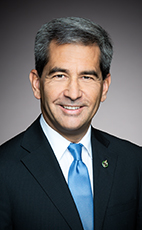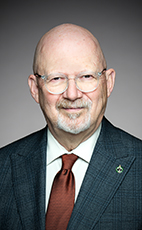44th Parl. 1st Sess.
April 5, 2022 10:00AM
- Apr/5/22 10:29:53 a.m.
- Watch
Mr. Speaker, I thank my colleague for her speech.
It is pretty clear that there needs to be more investment in the Canadian Armed Forces. The 2% target was set during an international agreement with people from NATO and it is reasonable.
However, there are a lot of questions about procurement and many concerns about wasting public money. I would like my colleague's opinion on that.
We only have to look at the saga with the fighter jets that were cancelled in 2015. The Liberals promised they would never buy them, but now they announce that they are doing just that. If those jets had been purchased several years ago, they may have been less expensive.
We can also think of the submarines. It makes no sense to buy four used submarines, one of which caught on fire. That claimed the life of one of our soldiers. What is more, if only one submarine had been purchased, it might still be operational.
I would like my colleague to tell us what can be done to improve the way public funds are managed. Is there a way we could pass a budget and depoliticize the procurement process? Could we entrust this to professionals to prevent it from becoming a promise made by a politician during an election campaign to win votes?
221 words
- Hear!
- Rabble!
- add
- star_border
- share
- Apr/5/22 10:31:03 a.m.
- Watch
Mr. Speaker, I agree with my hon. friend on all his points, because there is a lot of waste in procurement. It is overpoliticized with this government. It needs to be streamlined.
We streamlined the procurement process when we were in Afghanistan. Canada showed it can be done. Once we withdrew, it became more complicated all over again. In the last seven years, the Liberal government has spent $865 million, and it spent another billion on used aircraft from Australia, only to get us back to the F-35s, which were the best choice all along for our needs here in Canada.
102 words
- Hear!
- Rabble!
- add
- star_border
- share
- Apr/5/22 10:31:52 a.m.
- Watch
Mr. Speaker, according to the Parliamentary Budget officer, for Canada to meet that 2% of NATO spending that the Conservatives are calling for, we would have to spend an additional $54 billion to $56 billion annually on defence, which is approximately double what we spend now.
Can the member clarify which government programs the Conservatives would cut in order to justify that increase in spending?
65 words
- Hear!
- Rabble!
- add
- star_border
- share
- Apr/5/22 10:32:23 a.m.
- Watch
Mr. Speaker, I am thankful for working alongside my friend on the Standing Committee on National Defence, where we usually get along very well.
The 2% is a pledge we made, and we should meet our commitment. We should be moving toward it and we should meet it. We have already semi-committed to the F-35s, although the minister said in the House that they are still working on it and the other minister said it is a done deal, so I am a little confused on that file. What I do know is we are in desperate need, and my friend knows this as well, being on the defence committee. We are understaffed and underequipped, and we need to fix it now.
124 words
- Hear!
- Rabble!
- add
- star_border
- share
- Apr/5/22 10:33:14 a.m.
- Watch
Mr. Speaker, I want to ask my colleague about the Cormorant helicopter fleet, because that is another category where the government has been dragging its feet. It initially budgeted to upgrade and repair the 14 helicopters back in 2017, but it seriously underbudgeted for that project. Those helicopters are essential for our air and sea rescue operations, and I am wondering if my hon. colleague could comment on this further foot-dragging by the Liberal government.
76 words
- Hear!
- Rabble!
- add
- star_border
- share
- Apr/5/22 10:33:45 a.m.
- Watch
Mr. Speaker, of course that is kind of the name of the game: the government dragging its feet when it comes to procurement and paying attention to what we need in search and rescue equipment for our military. Right now we have a retention and recruitment problem, and yet we are offering new recruits old equipment, which is equipment that literally may not work and might put their lives in danger. One of the best tools for recruitment and retention is to get the tools we need. Our SAR personnel are the best in the world, and they deserve the best equipment.
102 words
- Hear!
- Rabble!
- add
- star_border
- share
- Apr/5/22 10:34:31 a.m.
- Watch
Mr. Speaker, I have been looking forward to joining the debate on this motion. As a former member of the military, I understand the importance of adequate funding for national defence and the importance of Canada's role on the international stage.
The purpose of the debate is to bring all parliamentarians to a clear consensus on our defence posture. The motion specifically calls for an increase in the defence budget to reach the NATO target. However, we also need to find another time to discuss the state of the troops and lack of members. There is a reason for all that, but we will come back to it another day.
From the outset, I must say that the Liberals' rhetoric about military spending has never translated into concrete action, and that is very disappointing. Most frightening is this recent partnership between the Liberal Party and the NDP socialists. It is no secret that the NDP has never been in favour of a healthy and well-funded Canadian military. Under a NDP government, the Canadian Armed Forces' budget would basically be eviscerated. As a result of this romance between the Liberals and the NDP, there is uncertainty among our troops across the country and abroad.
When Russia invaded Ukraine, all NATO partners were again challenged to meet or maintain the defence spending requirement of 2% of GDP, 20% of which must be allocated to military equipment. This renewed commitment had actually been discussed at the 2014 NATO summit in Wales, in response to Russia's illegal annexation of Crimea and the unrest in the Middle East at that time. NATO leaders agreed to reverse the downward trend in defence spending and decided that the allies already meeting the 2% guideline on defence spending would strive to continue doing so and that the allies spending less than 2% of their GDP on defence would strive to increase that spending in real terms within 10 years.
That commitment was made in 2014, and now, eight years later, Canada ranks 25th out of the 30 NATO countries in terms of military spending. NATO's latest annual report shows that Canada spent just 1.36% of its GDP on the army and new defence equipment in 2021.
In contrast, the Conservative Party of Canada declared in its policy statement that a Conservative government will work towards spending at least the NATO recommended 2% of our GDP on national defence. Furthermore, in our latest platform, in 2021, we said, “Canada’s Conservatives will renew Canada’s commitment to NATO by increasing spending on national defence to move closer to our 2% aspirations”.
The large-scale invasion of Ukraine by Russia, accompanied by mounting evidence of war crimes in full view of anyone on social media, clearly gives Canada good reason to considerably increase its defence spending.
There is no doubt that Canada's biggest challenge has always been its procurement system, which involves too many departments and not enough political responsibility. This system essentially created a bottleneck that prevents even the current budget increase from being spent effectively. The lack of political leadership keeps projects from moving quickly. Every independent procurement expert who testified before our committees has said as much.
According to the most recent public accounts, $1.2 billion of 2021 defence spending was not invested, despite the fact that the Liberal's 2015 election platform explicitly states, “We will not let Canada’s Armed Forces be shortchanged, and we will not lapse military spending from year to year.” However, last month the Parliamentary Budget Officer released a report detailing how the Liberals are constantly pushing spending to coming years. In other words, the Liberals have consistently broken their promise to invest in new equipment.
To be honest, when the “Strong, Secure, Engaged” defence policy was published in 2017, I was impressed. During a meeting of the Standing Committee on National Defence, at the time, I remember saying to the chief of the defence staff and the Minister of Defence that 80% of what was in the white paper advocated a Conservative approach. I asked how they were going to fund it. The told me that the decision was not theirs to make. We saw what happened next.
At the same time, Canada's defence policy entitled “Strong, Secure, Engaged” demonstrates how the Liberals calculate defence investments so as to meet NATO criteria. It is as though they are comparing this year's 1.34% with the Conservatives' percentage, which the Liberals estimate at just under 1%. We need to compare apples to apples and oranges to oranges.
The Liberals added elements to the NATO calculations. There are ongoing discussions about applying the same yardstick. Certain elements have been included, such as payments made to veterans. They were not part of the NATO calculations, nor were peacekeeping and humanitarian operations, defence-related IT support, centrally funded defence personnel expenditures, or support for defence programs.
The Liberals took a look and, anywhere they saw the word “defence” or “veteran”, they decided they would take that and put it all together to inflate the percentage so they could say that they are doing more. That is the big difference between what was done by the Conservatives at the time, in other words, real and actual defence work, and the other things that the Liberals picked at here and there.
We know that the Liberals are sneakily trying to cover up their failure. However, Canadians are not fools. They see what the Liberals are doing. The only major project that the Liberals have completed in nearly seven years is buying a bunch of rusted-out CF-18s from Australia for $360 million. We congratulate them on that.
With regard to Ukraine, Canada can and must do more. We have a lot of surplus military vehicles that could be dispatched around the clock with our C-17s. However, the government has not indicated whether it has even considered such action. We could also call upon third parties to buy air defence equipment, such as Stinger missiles or drones and send them to Ukraine. Once again, the senior officials who appeared before the Standing Committee on Government Operations and Estimates repeatedly suggested that these ideas are not even being considered right now.
Furthermore, all military purchases under this Liberal government are or have been delayed. For example, when will Canada sign the notorious F-35 contract? We have been in the consortium for decades. Why do we have to wait seven months to enter into dialogue with Lockheed Martin? We have already been talking to them for quite a while now. In addition, when will construction on the polar icebreakers begin? Why is the Davie shipyard still not officially part of the national shipbuilding strategy? What is this government waiting for? How are we going to protect Canadian sovereignty in the Arctic? The NORAD alert system is totally obsolete. Has the government considered purchasing airborne warning and control system aircraft? What are we doing to speed up the procurement process? What is the status of the submarine replacement program?
In addition, this partnership between the Liberals and the NDP is a pretty good indication that this government is unlikely to increase investments in the Canadian Armed Forces in the short term. Indeed, how many times have we heard NDP statements or resolutions calling for Canada to withdraw completely from NATO?
When we, the Conservatives, were in power, we finalized the purchase of five C-17 Globemaster transport aircraft, 17 CC-130J Hercules transport aircraft, 15 Chinook helicopters and some Leopard 2 tanks. We modernized the CP-140 Aurora surveillance aircraft and the Halifax class frigates. We approved the construction of the Asterix auxiliary supply ship, which the Liberals tried to cancel at their first cabinet meeting in 2015, despite Admiral Norman's objections. We established the national shipbuilding strategy, which, despite all its problems, is finally starting to produce some ships, such as the Coast Guard's science vessels and the Arctic offshore patrol ships.
The Conservative government has always taken the need to provide adequate funding to our Canadian Armed Forces seriously, whereas the Liberals are known for spewing empty rhetoric. I will close by saying this. Let us do better in military procurement, let us be efficient and let us ensure we have the means to do so.
1410 words
All Topics
- Hear!
- Rabble!
- add
- star_border
- share
- Apr/5/22 10:44:06 a.m.
- Watch
Mr. Speaker, I thank the member for his intervention today. I know that when he and I were on the defence committee together a number of years ago, I believe it was in 2016 or 2017, the defence committee had brought forward a report that had a recommendation in it. It was the opinion of the committee at the time to increase defence spending to 2% of GDP, notwithstanding the fact that there can be a lot of complications with respect to that 2%, because not every country calculates it the same way.
Can the member comment on what, if any, work the committee has done since my time with him on that committee in terms of making any further recommendations around this issue?
124 words
- Hear!
- Rabble!
- add
- star_border
- share
- Apr/5/22 10:44:57 a.m.
- Watch
Mr. Speaker, I thank my colleague for the question.
I am no longer a member of the Standing Committee on National Defence, so I am not completely up to date on all the reports that have been produced over the past five years, but the fact remains that the 2% issue keeps coming up. Something tangible needs to be done. The budgets have been lacking the past few years. For example, there is the “Strong, Secure, Engaged” policy. The committee can say what it wants, and it makes recommendations in its reports that are often quite good, but the government never follows through.
105 words
- Hear!
- Rabble!
- add
- star_border
- share
- Apr/5/22 10:45:39 a.m.
- Watch
Mr. Speaker, there is some catching up to do when it comes to equipment. My colleague talked about that. The national shipbuilding strategy is very costly and is experiencing near‑record delays.
Would immediately fast-tracking the inclusion of a third shipyard be a solution not only to improve this 2%, but also to increase youth engagement in our naval force and in shipbuilding?
65 words
- Hear!
- Rabble!
- add
- star_border
- share
- Apr/5/22 10:46:13 a.m.
- Watch
Mr. Speaker, I thank my colleague for the question. Everything having to do with defence forms a big circle. Having operational resources and good, modern equipment encourages young people to enrol in the Canadian Forces and serve their country.
I doubt that 17- or 18-year-olds are reassured by what is happening with the jets and the ships. They are not sure what is going to happen. Eventually, they will decide to do something else with their life.
An acquaintance of mine, who had dual French and Canadian citizenship and wanted to be a pilot, decided to return to France after seeing the state of the F‑18s compared to France's aircraft. Now he is piloting French jets. That just proves that we really do not have anything to offer that would appeal to young Canadians, unfortunately.
140 words
- Hear!
- Rabble!
- add
- star_border
- share
- Apr/5/22 10:47:07 a.m.
- Watch
Mr. Speaker, I think the hon. member for Charlesbourg—Haute-Saint-Charles has missed a couple of things. I know he was only elected in 2015, so he missed the fact that the Conservatives let defence spending drop to its lowest level since the 1930s while they were in government. He seems to have missed that the NDP has voted for every increase in military spending since 2016. He also seems to have missed that the NDP changed its policy on NATO nearly 30 years ago.
I wonder if the hon. member would like to explain how the Conservatives have gone from taking defence spending to its lowest level ever to now endorsing an arbitrary doubling of defence spending.
120 words
- Hear!
- Rabble!
- add
- star_border
- share
- Apr/5/22 10:47:44 a.m.
- Watch
Mr. Speaker, I thank the member for his question. Those were different times. Let us not forget Afghanistan and spending on the operation in Afghanistan. The equipment I mentioned in my speech was purchased by the Conservatives to quickly meet an urgent need to support the troops.
Ask anyone who was in the Canadian Armed Forces when the Conservative government was in power if they were ashamed to serve their company, and no one would say they were. The military knew very well that the Conservative government was there to support them to the fullest extent, and that it could react quickly and send in the operational equipment that was needed on the ground. That is more important than any speech.
121 words
- Hear!
- Rabble!
- add
- star_border
- share
- Apr/5/22 10:48:27 a.m.
- Watch
Mr. Speaker, I want to thank and congratulate my colleague for the good work that he does at the Standing Committee on Government Operations and Estimates and on this type of national security file.
I filled in for my colleague once at a committee. At that meeting, we learned that contracts to upgrade radar systems in the Canadian Arctic had not been awarded.
Are there concerns about the government's refusal to upgrade radar systems in the Canadian Arctic?
79 words
- Hear!
- Rabble!
- add
- star_border
- share
- Apr/5/22 10:48:57 a.m.
- Watch
Mr. Speaker, I thank my colleague from Lévis—Lotbinière. The Arctic is an immense and complex area that requires surveillance. Essentially, that requires an effective radar system. At present, the radar system in place is outdated. The government has stated that it has invested more than $600 million, but that is for standard maintenance. It is not deploying any new equipment. The U.S. is worried and is asking us to do our fair share and invest in equipment in order to provide air and maritime surveillance as quickly as possible.
97 words
- Hear!
- Rabble!
- add
- star_border
- share
- Apr/5/22 10:49:37 a.m.
- Watch
Mr. Speaker, I will be splitting my time with the member for Don Valley West this morning.
I rise in the House to talk about the progress we have made in implementing Canada's defence policy of Strong, Secure, Engaged. When we first released SSE back in 2017, we provided a comprehensive list of capital projects, policies and procedures to ensure that our military could meet our biggest defence and security threats now and into the future. To help fund these items, SSE also forecasted a steady increase in defence spending from $18.9 billion in 2017-18 to $32.7 billion in 2026-27. That is an increase of 70% to our defence spending. Even prior to the COVID-19 pandemic, Russia's unprovoked war in Ukraine and the myriad of other defence and security challenges we have faced over the past five years, we were already on track to increase defence spending by more than 70%.
While SSE remains our main guide for making sure CAF members are well supported and well equipped, the evolving global security environment has underscored just how important and urgent our investments in defence are. That is why, as both the Prime Minister and the Minister of National Defence have indicated, we will be further increasing our investments in defence, including a comprehensive spending package going toward continental defence.
With that in mind, I want to give the House an update on the progress that DND has made in implementing this policy so far, and on the work that we are doing to safeguard our country and continent and support our allies and partners in good times and in bad. Key to these efforts is having a well-supported, resilient workforce that feels safer coming to work every day. When DND launched SSE in 2017, it included several critical initiatives aimed at supporting CAF members and their families throughout their entire careers. This included developing a total health and wellness strategy with the goal of supporting defence team members' mental and physical well-being at all times.
I am pleased to note that National Defence launched this strategy earlier last month. Over the next several years, it will invest more than $950 million to enhance health and wellness programs and services for defence team members, including expanding the Office of Disability Management by adding more regional offices across the country, providing personalized support services to injured, ill and impaired public service employees, and improving care for Canadian Armed Forces members who are recovering from an illness or injury. Through SSE, National Defence has also done important work expanding the services offered to military families through military family resource centres, and has helped address the challenges that come with a life in uniform through the seamless Canada initiative, which helps to address gaps in service when military families are posted across the country and must navigate new school systems, careers and health care settings.
These are just a couple of the initiatives in SSE aimed at supporting defence team members and their families. We know that Canada's position in the world and our safety and security here at home come down to the well-being of those who serve in it. All that we do, from procurement to health care to cultural change, must be focused on the people who put service before self, the members of our Canadian Armed Forces.
At the same time, we know that our people in uniform need the right equipment to do the difficult jobs that we ask of them. They need state-of-the-art fit-for-purpose tools that can meet the challenges of modern warfare across all domains. In SSE, National Defence outlined over 300 capital projects critical to our military success and our continued interoperability with allies and partners for decades to come. While the COVID-19 pandemic has certainly contributed to project delays and supply chain disruptions, we remain committed to delivering on these projects, providing the very best equipment for our people in uniform while ensuring Canada's economy benefits from our defence investments.
Despite the challenges of the past few years, we are making progress. In fact, since 2017, 75% of the policy's capital projects, which is 258 projects, are in the implementation phase, near completion or completed. Several high-profile projects kept moving forward even as much of the world shut down.
Just last week, the Minister of Public Service and Procurement and the Minister of National Defence announced that Canada was moving into the finalization phase of the future fighter competition with Lockheed Martin and the U.S. government. If an agreement is successfully reached, Canada could see initial aircraft deliveries as early as 2025. This is the most significant investment in the Royal Canadian Air Force in over 30 years, so we have been taking the time. We need to get this right and ensure that we are purchasing the right jet with the right value for CAF and Canadians.
We have taken the same careful, considered approach to building our fleet of Arctic and offshore patrol ships for the Royal Canadian Navy. The first of these ships, HMCS Harry DeWolf, has already participated in missions like Operation Nanook and Operation Caribbe, and has transited through the Panama Canal. It also recently completed a circumnavigation of North America, the first Royal Canadian naval ship to do so since 1954. The second ship, HMCS Margaret Brooke, has completed the ship's icebreaking and Arctic environmental trials and will return to Arctic waters to participate in the maritime portion of Operation Nanook this summer. The third, fourth and fifth AOPS are in various stages of construction, with the construction of the sixth AOPS expected to begin later this year.
As we deliver on these critical projects for our navy and air force, we are also delivering on our promise to provide the Canadian army with a fleet of 360 armoured combat support vehicles. These vehicles have been designed to replace our current fleet of LAV II Bison and M113 tracked LAV fleet. They are more mobile with longer operational range, better equipped to conduct operations at night and in bad weather and safer for our people in uniform, offering improved protection against weapons and explosives. The first of these vehicles are expected to be delivered to the Canadian army later this year.
The investments under Canada's defence policy ensure that we deliver the equipment, infrastructure and innovation to help our military advance our national security objectives and interests. However, they are also critical to our national prosperity, resilience and economic well-being. As the largest federal employer, National Defence and the Canadian Armed Forces have a significant presence in every province and territory, so investing in defence also means creating more jobs and generating economic benefit for communities from coast to coast to coast. These investments also mean that we are better positioned to support our allies and partners across the globe, including those under threat from Russian aggression.
Through SSE, we are committed to remaining engaged in the world now and into the future. We are supporting Ukraine in its fight for freedom and self-governance, standing shoulder to shoulder with our NATO allies on Operation Reassurance and Operation Impact, both of which we recently extended, and deploying wherever and whenever CAF support can make a difference. In times of global uncertainty, we know that our mutual relationships are even more important, and our SSE investments will help us remain effective and a reliable, stable partner within NORAD and NATO for decades to come.
When we launched Strong, Secure, Engaged back in 2017, we made sure that it was flexible enough to deal with a rapidly evolving defence and security environment. This means that while there are certain challenges that DND and CAF could not have anticipated, chiefly the global pandemic, they have remained ready to respond and had the flexibility to adjust timelines accordingly. As we continue discussing ways to increase defence spending, this policy will remain our government's road map, enabling us to strengthen our defences here at home and help uphold peace and security across the globe.
1365 words
All Topics
- Hear!
- Rabble!
- add
- star_border
- share
- Apr/5/22 10:59:20 a.m.
- Watch
Mr. Speaker, I want to ask again about the Cormorant helicopter fleet. My understanding is that these helicopters are reaching their end of life. We are having to cannibalize parts from other helicopters to keep them in the air. They were essential in the search and rescue operations during the floods in British Columbia last summer, and they are a key factor in our air and sea search and rescue operations. Some 360 jobs would come from the upgrading and refurbishment of these helicopters, yet they were budgeted for in 2017 and nothing has happened. Fixing these helicopters would cost about $1.4 billion and would go a long way in helping us meet our NATO target of 2%.
Could the member comment on that specific project?
127 words
- Hear!
- Rabble!
- add
- star_border
- share
- Apr/5/22 11:00:14 a.m.
- Watch
Mr. Speaker, the safety of our personnel is always top of mind and the RCAF has a robust flight safety program. We know that we need to move forward in looking at a procurement project for these. As the member spoke about, cracks were discovered on the tail of the Cyclone helicopter undergoing a recent maintenance inspection. We know that we need to maintain safe equipment for all members of CAF, and we will make sure that all equipment is capable before it is used.
85 words
- Hear!
- Rabble!
- add
- star_border
- share
- Apr/5/22 11:01:01 a.m.
- Watch
Mr. Speaker, my colleague spoke about the importance of securing the supply chain, which has been weakened during the pandemic.
I would like to talk about something that is very important for Quebec. The government is set to spend a huge amount of money on F-35s, but there is no guarantee of any industrial or technological benefits. Quebec accounts for more than 50% of Canada's aerospace industry.
When will the member's government adopt a real aerospace policy that recognizes the importance of this sector, in particular in Quebec? This could help secure our supply chain.
98 words
- Hear!
- Rabble!
- add
- star_border
- share
- Apr/5/22 11:01:43 a.m.
- Watch
Mr. Speaker, I too share this interest. Being the member of Parliament for Cambridge, we have a number of companies in my riding in the aerospace industry, such as Honeywell, formerly COM DEV, among others. This is something that is critically important to our moving forward to ensure that any procurements, whether it be the fighter jets or others, benefit us not just by having the right equipment for members of CAF but also, wherever possible, by helping our local economies here in Canada.
84 words
- Hear!
- Rabble!
- add
- star_border
- share
- menumenu
- notificationsnotifications
- home
- mailmail
- searchsearch













